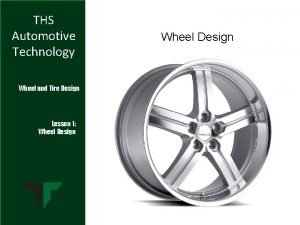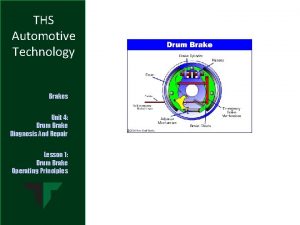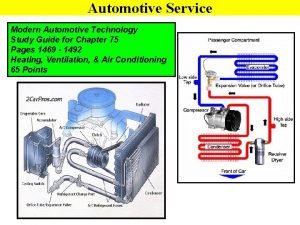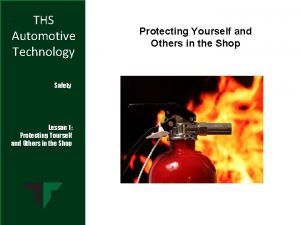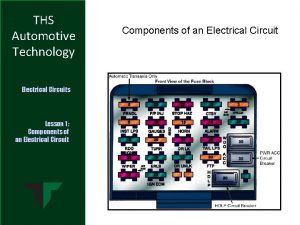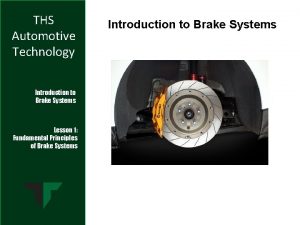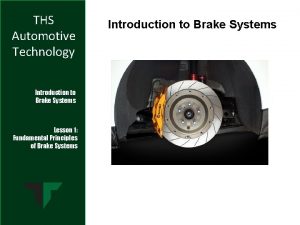THS Automotive Technology Safety Lesson 2 Shop Safety













- Slides: 13

THS Automotive Technology Safety Lesson 2: Shop Safety Features and Emergency Procedures

THS Automotive Technology Safety Lesson 2: Shop Safety Features and Emergency Procedures Observe the following guidelines about safety features and equipment in a shop. • Walk around the shop to become familiar with the various areas (e. g. , work bays, management offices, parts department, customer waiting area) and the traffic flow of vehicles coming in and out of the shop. • Note the location of shop exits, which should be wellmarked with an “EXIT” sign. Keep the area around the exits free of obstructions. • Be familiar with the shop’s evacuation routes and procedures in case of fire or other emergencies. • Note the location of specific work areas, such as those for welding, painting, and grinding, which should be clearly marked. • Know the location and how to operate the eye wash station, which is used to flush the eyes in case of a chemical splash.

THS Automotive Technology Safety Observe the following guidelines about safety features and equipment in a shop. • Know where the first-aid supplies are kept and be familiar with the supplies available and how to use them. • Locate the telephones that can be used for emergencies and where emergency numbers are posted. • Note the location of storage containers for hazardous wastes and materials. Lesson 2: Shop Safety Features and Emergency Procedures

THS Automotive Technology Safety Lesson 2: Shop Safety Features and Emergency Procedures Observe the following guidelines about safety features and equipment in a shop. • Know the location of the shop’s fire blanket. Every shop must have a 100% wool fire blanket. The fire blanket can be wrapped tightly around a person who is on fire to smother the flames. Avoid using a fire blanket on a burning person wearing synthetic clothing. Doing so can cause serious skin damage. Use water to extinguish burning synthetic clothing. Work coveralls and shop clothing should be made of cotton. CAUTION: Do not allow a person on fire to run.

THS Automotive Technology Safety Lesson 2: Shop Safety Features and Emergency Procedures Observe the following guidelines about safety features and equipment in a shop. • Know where the fire alarm is and how to activate it at the first sign of a fire that has any possibility of getting out of control. • Know where fire extinguishers are located and how to use them. It is critical to be familiar with how the fire extinguishers in the shop operate to be prepared if a fire should start.

THS Automotive Technology Observe the following guidelines about safety features and equipment in a shop. Types of fire extinguishers • Class A — Plain water Safety • Class BC — May be carbon dioxide, ordinary dry chemical, or halon • Class ABC — Multipurpose dry chemical Lesson 2: Shop Safety Features and Emergency Procedures • Class D — Dry powder Classes of fires and the appropriate extinguisher for each • Class A fires include burning paper, wood, rubber, cloth, and other materials commonly found in classrooms and offices. These fires may be effectively handled with either a dry-chemical or water fire extinguisher. • Class B fires include burning liquids, gases, grease, and oil. Use only dry-chemical fire extinguishers. Water fire extinguishers cause the burning liquid to spread.

THS Automotive Technology Safety Lesson 2: Shop Safety Features and Emergency Procedures Observe the following guidelines about safety features and equipment in a shop. • Class C fires are electrical fires. Use only a Class C fire extinguisher that contains dry chemicals and carbon dioxide. Water or foam-type fire extinguishers can electrocute people in the area. • Class D fires include burning metals, such as magnesium or sodium. Use only Class D fire extinguishers that contain the appropriate dry powder and are identified by a 5 -point star with the letter “D” printed within the star. NOTE: Most shops use multiple-class fire extinguishers that can be used on Class A, B, and C fires.

THS Automotive Technology Observe the following guidelines about safety features and equipment in a shop. Universal symbols for fire extinguishers Safety Lesson 2: Shop Safety Features and Emergency Procedures General procedure for using a fire extinguisher CAUTION: Do not operate a fire extinguisher if not trained to do so, if the flames are large or progress beyond their initial stage, or if the fire becomes too hot or smoky. If there is any doubt about being able to extinguish the fire, evacuate the building immediately. CAUTION: Before attempting to put out a fire with a fire extinguisher, be sure to identify a safe evacuation route.

THS Automotive Technology Safety Lesson 2: Shop Safety Features and Emergency Procedures Observe the following guidelines about safety features and equipment in a shop. NOTE: The instructor will demonstrate the properation of the fire protection equipment available in the shop. Most fire extinguishers operate using the P. A. S. S. method, which is included below. • Pull — Pull the pin, ring, clip, etc. from the extinguisher’s handle. This action will break the tamper seal. • Aim — Aim the extinguisher nozzle at the base of the flames. • Squeeze — Squeeze the extinguisher handle to release the contents. • Sweep — Sweep from side to side at the base of the flames, discharging the extinguishing agent until the fire is out.

THS Automotive Technology Safety Lesson 2: Shop Safety Features and Emergency Procedures Observe the following guidelines about safety features and equipment in a shop.

THS Automotive Technology Safety Lesson 2: Shop Safety Features and Emergency Procedures The importance of maintaining cleanliness and order in the shop • A clean shop environment reduces the hazards of slipping and soiling clothing. It also protects vehicles from grease or paint damage. • An orderly shop with clear pathways allows employees easy access to exits. Regulations from the EPA and local fire codes empower the local fire marshal to insist on an orderly, uncluttered, and safe shop area. • Keep tools, equipment, and supplies organized to allow greater efficiency. Store tools, equipment, and supplies in their proper place when not in use. • A clean and orderly shop is the mark of competent professionals and promotes business growth.

THS Automotive Technology Safety Lesson 2: Shop Safety Features and Emergency Procedures Emergency procedures • If someone is injured in the shop, notify the instructor at once. • Do not give first aid to a victim unless trained to do so. However, if properly trained, do not hesitate to give first aid. • If someone comes into contact with electrical current and receives an immobilizing shock, do not try to move him or her if the current is still on and the person is still in contact with it. Shut off the main circuit to the shop. Electrical current will flow through whoever touches the person being shocked. Notify the instructor at once.

THS Automotive Technology Safety Emergency procedures • General fire emergency procedure NOTE: Specific procedures for dealing with fire emergencies vary. It is important to know the specific procedures for your shop. If a person is on fire, immediately wrap the person in a fire blanket to smother the flames. For other fires, turn on the fire alarm. Lesson 2: Shop Safety Features and Emergency Procedures Notify the instructor as soon as possible. The instructor will decide whether or not to attempt to extinguish the fire or to wait for emergency personnel. Turn off any machines and power in the event of an alarm if time or circumstances allow. Follow building evacuation procedures as required.
 Ths automotive
Ths automotive Ths automotive
Ths automotive Wheel tire design
Wheel tire design Non servo drum brakes
Non servo drum brakes Flow shop vs job shop
Flow shop vs job shop Automotive technology principles diagnosis and service
Automotive technology principles diagnosis and service Modern automotive technology answer key
Modern automotive technology answer key China automotive technology & research center
China automotive technology & research center Automotive technology sixth edition
Automotive technology sixth edition Control system
Control system Structural mechanics exam questions
Structural mechanics exam questions Autocaat
Autocaat Mechanical technology automotive grade 10
Mechanical technology automotive grade 10 Ths ldk
Ths ldk


